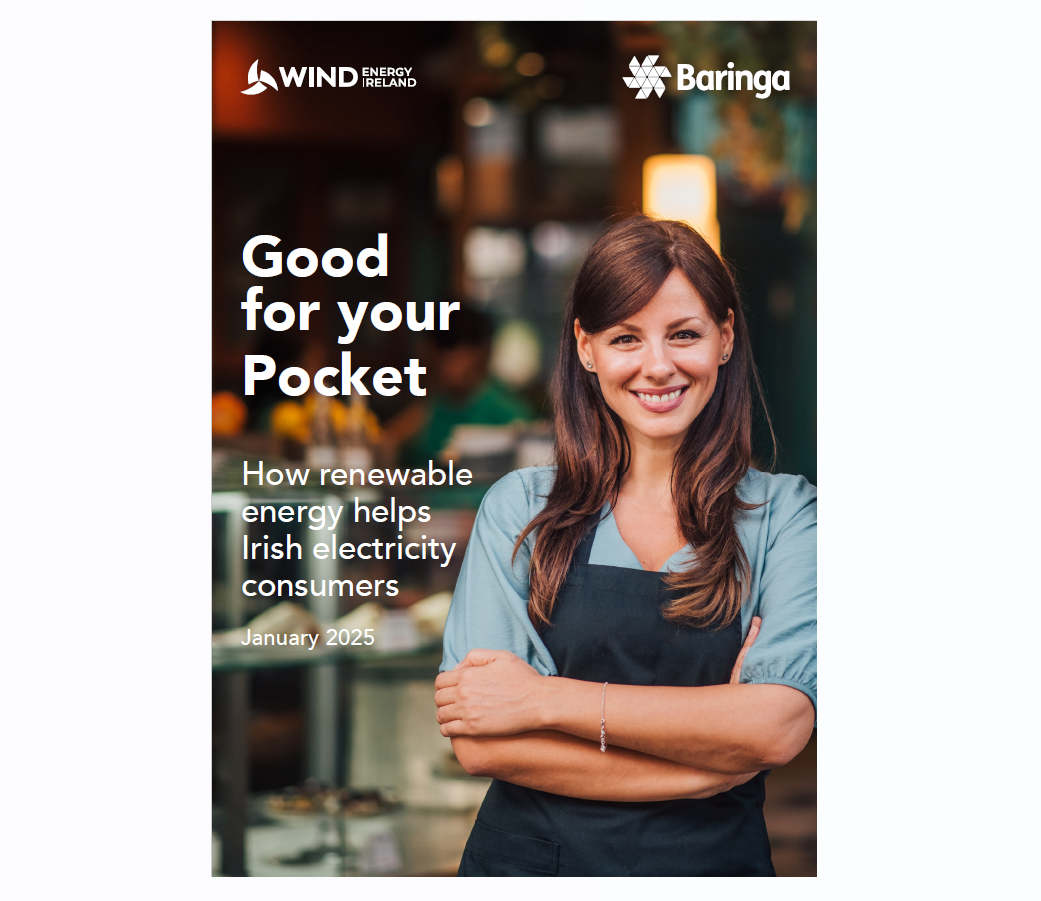
Good for your Pocket: How renewable energy helps Irish electricity consumers
4 min read 16 January 2025
The development of wind and solar farms has reduced the costs for Irish consumers by €840 million between 2000 and 2023. This saving—equivalent to €165 per person—is due to the low cost of renewable electricity: Wind and solar farms have no fuel cost and undercut more expensive gas- and coal-fired generators, displacing them from the wholesale power market.
Good for your pocket: How renewable energy helps Irish electricity consumers, found that if Ireland continues to invest in wind and solar projects, and achieves the national target of 80% renewable electricity, consumer bills could be reduced by €610 million per year.
Ireland’s renewable transition has also avoided more than 47 million tonnes of CO2 between 2000 and 2023, equal to the lifetime emissions of 1.1 million midsized cars, 40% of the total vehicles in Ireland.
Read this report, commissioned by Wind Energy Ireland, a renewable industry organisation, for:
- The savings conferred to consumers by Irish renewable energy since 2000
- The potential further savings that could be unlocked if Ireland continues to invest in renewables
- The volume and value of fossil fuels left in the ground
- The carbon emissions avoided
Read the report to find out more |
Wind Energy Ireland (WEI) is the representative body for the Irish wind industry, working to promote wind energy as an essential, economical and environmentally friendly part of the country’s low-carbon energy future.
What does this mean for you?
What happens if Ireland’s progress towards 80% renewable electricity is delayed beyond 2030?
Good for your Pocket shows the size of the prize – incremental consumer savings of €610 million – if the government ambition is realised. This result has been calculated relative to a baseline scenario, in which no more renewables are built from today’s levels.
Our findings therefore show that any delays to the delivery of renewables have a material impact on consumer bills. The key benefit offered by wind and solar farms is only realised once the projects are approved, connected to the power grid, and producing low-cost electricity.
The €610 million net saving is an annual figure, and similar savings would be conferred to consumers in subsequent years once the renewable capacity is deployed. The faster renewables can be deployed, the greater the cumulative savings – for both consumer costs, and CO2 emissions.
Have consumers in other markets saved from the development of renewables?
The exact line items included in power bills, and the way they are divided across consumers, varies from market to market. In geographies with competitive market arrangements, in which generators are dispatched according to their running costs, renewables will be able to lower the wholesale cost of electricity in the same way they have done so in Ireland.
The overall impact on consumer bills will then depend on the size of this saving relative to the costs incurred to support renewable projects, integrate them onto the grid, and balance the system.
Read our report on the cost impact of renewables in Northern Ireland, Renewable Rewards, a study published by RenewableNI in September 2024, which used the same models and assumptions as Good for your Pocket. Our study revealed that Northern Irish consumers have also saved from the renewable transition – a total of £200 million since 2000.
For more information, reach out to Mark Turner and Alec Granville-Willett.
Related Insights

Did you miss out on Italy's MACSE Auction? Here is why you shouldn’t give up
Developers now face a pivotal decision. Do you learn from these tough results, refine your bid, and compete fiercely in the next MACSE auction, or, pivot to a targeted merchant strategy, capturing value where subsidies won’t reach?
Read more
Podcast - S3-E2 - Decarbonising complex industries
Navigating the challenges of decarbonisation while maintaining energy security.
Read more
Navigating the new domestic decarbonisation landscape
Baringa’s ninth Green Buildings and Transport Forum on 3 December 2025 brought together a range of market players to discuss the future of warm homes.
Read more
Getting the balance right: Australian data centre growth and the energy transition
Baringa's analysis for the Clean Energy Finance Corporation forecasts that data centres could represent up to 11% of Australia’s total electricity consumption by 2035.
Read moreIs digital and AI delivering what your business needs?
Digital and AI can solve your toughest challenges and elevate your business performance. But success isn’t always straightforward. Where can you unlock opportunity? And what does it take to set the foundation for lasting success?
